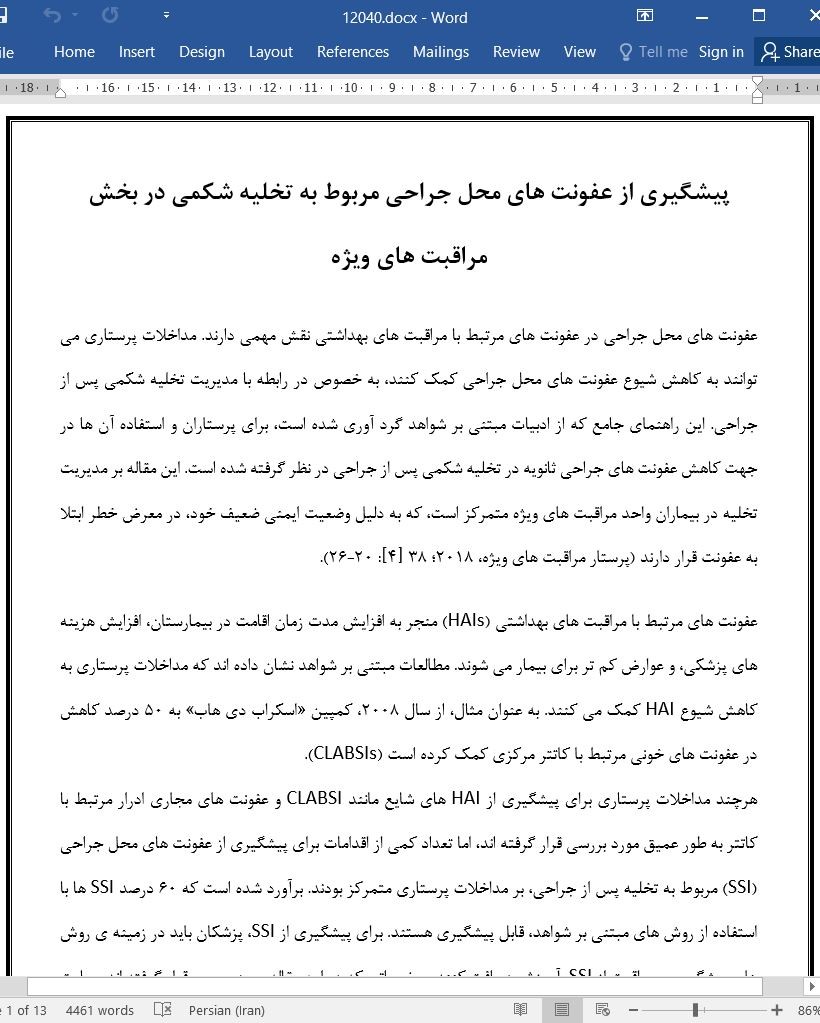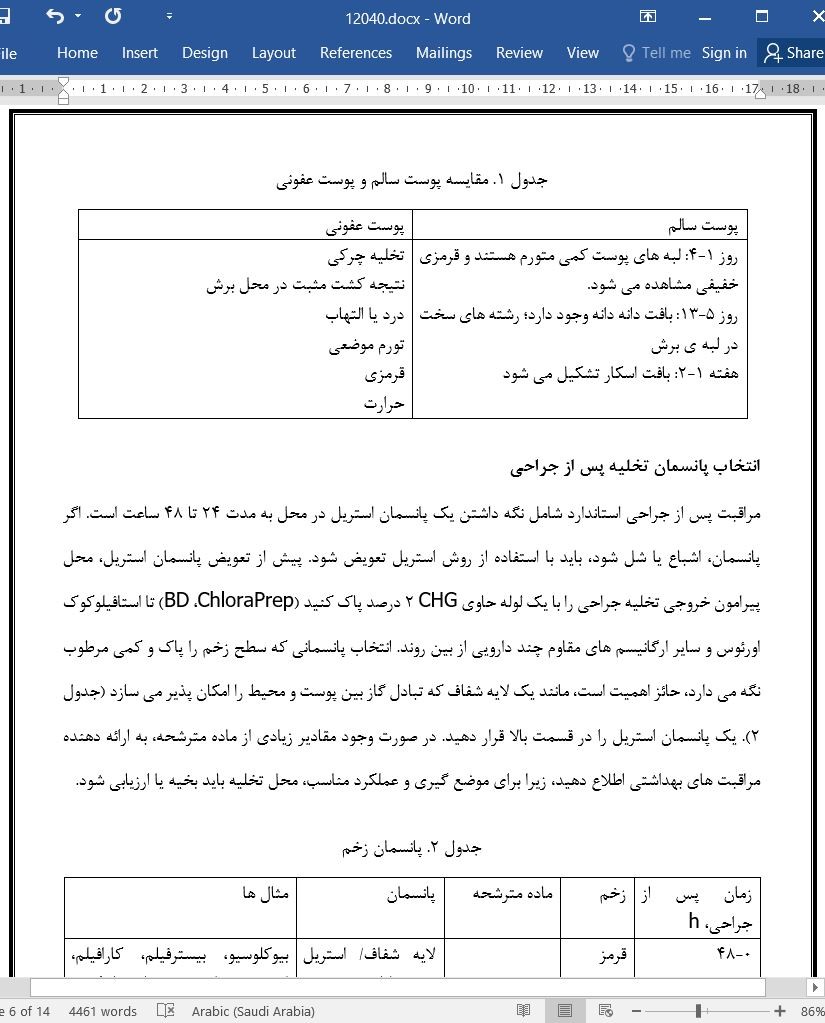
پیشگیری از عفونت های محل جراحی مربوط به تخلیه شکمی در بخش مراقبت های ویژه
عفونت های محل جراحی در عفونت های مرتبط با مراقبت های بهداشتی نقش مهمی دارند. مداخلات پرستاری می توانند به کاهش شیوع عفونت های محل جراحی کمک کنند، به خصوص در رابطه با مدیریت تخلیه شکمی پس از جراحی. این راهنمای جامع که از ادبیات مبتنی بر شواهد گرد آوری شده است، برای پرستاران و استفاده آن ها در جهت کاهش عفونت های جراحی ثانویه در تخلیه شکمی پس از جراحی در نظر گرفته شده است. این مقاله بر مدیریت تخلیه در بیماران واحد مراقبت های ویژه متمرکز است، که به دلیل وضعیت ایمنی ضعیف خود، در معرض خطر ابتلا به عفونت قرار دارند (پرستار مراقبت های ویژه، 2018؛ 38 [4]: 20-26).
عفونت های مرتبط با مراقبت های بهداشتی (HAIs) منجر به افزایش مدت زمان اقامت در بیمارستان، افزایش هزینه های پزشکی، و عوارض کم تر برای بیمار می شوند. مطالعات مبتنی بر شواهد نشان داده اند که مداخلات پرستاری به کاهش شیوع HAI کمک می کنند. به عنوان مثال، از سال 2008، کمپین «اسکراب دی هاب» به 50 درصد کاهش در عفونت های خونی مرتبط با کاتتر مرکزی کمک کرده است (CLABSIs).
نتیجه گیری
برای کاهش موثر خطر بروز SSI مربوط به تخلیه شکمی، یک ارزیابی دقیق، حفظ تخلیه عادی، و ارتباط با ارائه دهنده مراقبت های بهداشتی در مورد علائم قطع کاتتر تخلیه باید انجام شود. هرچند بسیاری از این اقدامات در طول ارزیابی شیفت رخ می دهند، حفظ تخلیه یک فرآیند مداوم است که باید توسط پرستار کنترل شود، حتی در میان بیماران بی تحرک در بخش ICU. با دنبال کردن دستورالعمل های مورد بحث در این مقاله، پرستاران مراقبت های ویژه می توانند اطمینان حاصل کنند که حتی بیشتر بیماران دارای ایمنی ضعیف، به SSI مربوط به تخلیه های شکمی پس از جراحی دچار نیستند.
Surgical site infections are signifi cant contributors to health care–associated infections. Nursing interventions may help decrease the incidence of surgical site infections, particularly in regards to the management of postsurgical abdominal drains. This comprehensive guide, compiled from evidence-based practice literature, is intended for nurses to use to reduce surgical site infections secondary to postsurgical abdominal drains. This article focuses on drain management in intensive care unit patients, who are at risk for infection because of their immunocompromised state.
Health care–associated infections (HAIs) result in lengthened hospital stays, increased medical costs, and poorer patient outcomes.1 Studies of evidence-based practice have shown that nursing interventions help reduce the incidence of HAIs. For example, since 2008 the “Scrub the Hub” campaign has contributed to a 50% reduction in central catheter–associated bloodstream infections (CLABSIs).2,3
Conclusion
To effectively decrease the patient’s risk of developing an SSI related to abdominal drains, a thorough assessment, routine drain maintenance, and communication with the provider regarding indications for discontinuing the drainage catheter should be performed. Although many of these actions occur during the shift assessment, drain maintenance is a continual process that requires vigilance by the nurse, even among immobile patients in the ICU. By following the guidelines discussed in this article, critical care nurses can ensure that even the most immunocompromised ICU patients remain free of SSIs related to postsurgical abdominal drains.
پیش زمینه
مداخلات مربوط به پیشگیری از SSI
اقدامات احتیاطی استاندارد
سرکوب پیشگیری کننده استافیلوکوک اورئوس
ارزیابی تخلیه پس از جراحی
انتخاب پانسمان تخلیه پس از جراحی
حفظ وضوح تخلیه
تراز کردن کاتتر تخلیه
حفظ فشار منفی لامپ های جمع آوری
خالی کردن لوله فشار
پیشگیری از پیچ خوردگی
ارزیابی تخلیه
خالی کردن مخزن تخلیه
علائم قطع کاتتر تخلیه
نتیجه گیری
منابع
Background
Interventions to Prevent SSIs
Standard Precautions
Prophylactic Suppression of S aureus
Postsurgical Drain Assessment
Selection of the Postsurgical Drain Dressing
Maintaining Drain Patency
Flushing the Drainage Catheter
Maintaining Negative Pressure of Collection Bulbs
Stripping the Drainage Tubing
Preventing Kinks
Drainage Assessment
Emptying the Drainage Reservoir
Indications to Discontinue the Drainage Catheter
Conclusion
References
- اصل مقاله انگلیسی با فرمت ورد (word) با قابلیت ویرایش
- ترجمه فارسی مقاله با فرمت ورد (word) با قابلیت ویرایش، بدون آرم سایت ای ترجمه
- ترجمه فارسی مقاله با فرمت pdf، بدون آرم سایت ای ترجمه



